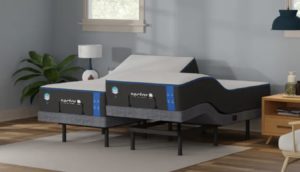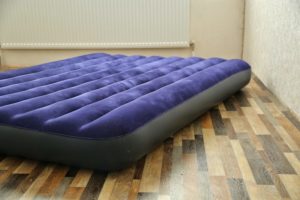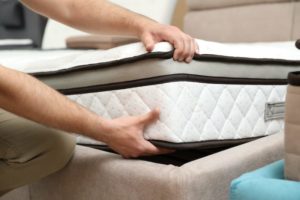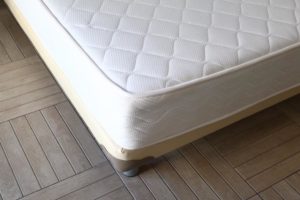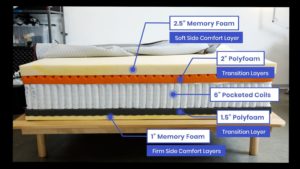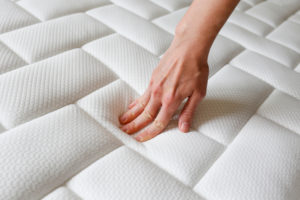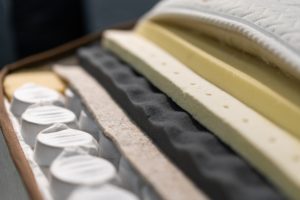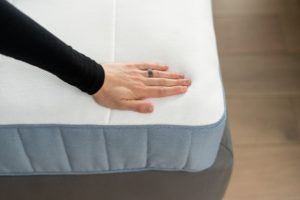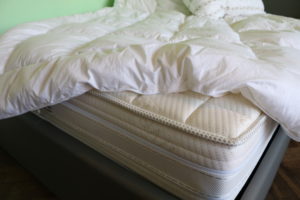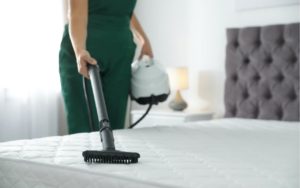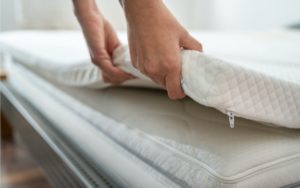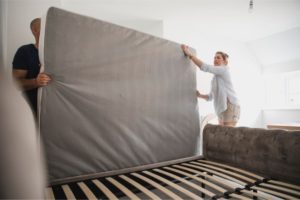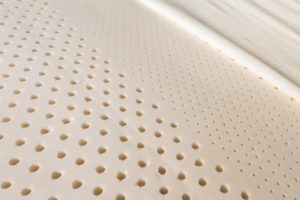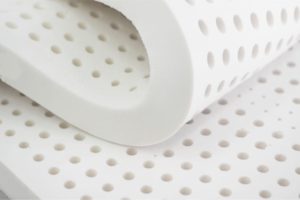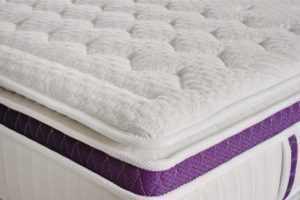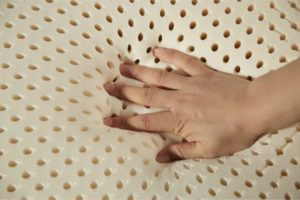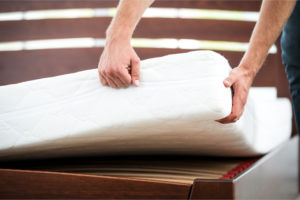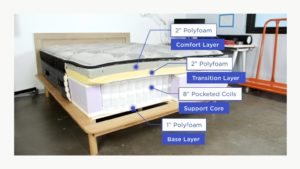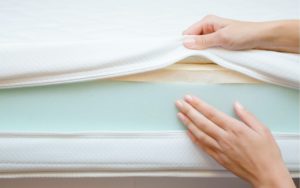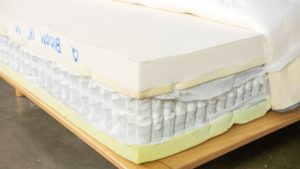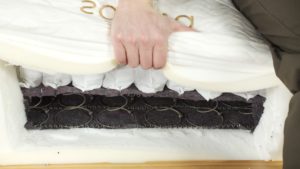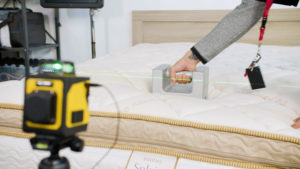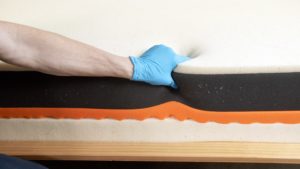How to Buy a Mattress Online
With the emergence of more and more direct-to-consumer online mattress brands, many shoppers have taken their mattress browsing from the local mattress showroom to the internet. It’s hard to beat the benefits. Buying a new mattress online often means a lower price tag, greater convenience, and a better selection.
The process of ordering a mattress online can seem daunting and even a little risky, but it doesn’t have to be. Buying a mattress online through the manufacturer is just as safe as buying from a brick-and-mortar store. Online shopping even comes with extra perks, like in-home sleep trials, that allow for an easier, low-risk experience.
If you’ve never purchased a mattress online, we’ll provide you with everything you need to know about this unique shopping experience so that you can find the best mattress for your needs.
Buying a Mattress Online
In many ways, buying a mattress online is easier than purchasing from a traditional brick-and-mortar store. However, the decision can be quite intimidating at first.
To help you get started, we’ll cover the entire process from start to finish, beginning with a step-by-step overview.
1. Consider Your Budget: Setting your budget upfront helps you narrow down the field and ensure you won’t break the bank for a good night’s sleep.
2. Choose a Mattress Type: Mattress materials such as memory foam, polyfoam, latex, and metal coils each have potential benefits for sleepers. When choosing a mattress, it’s important to understand fundamental differences between these materials in terms of feel, performance, and cost.
3. Choose a Mattress Firmness Level: The most comfortable firmness level for you depends on your sleep position, body weight, and personal preferences.
4. Choose a Mattress Size: Select from a range of standard mattress sizes based on your available space, preferred surface thickness, and whether you sleep with a partner.
5. Shop the Best Online Mattress Brands: Choosing a reputable online brand helps ensure you’ll receive a mattress with quality materials and construction as well as good customer service.
6. Consider Sleep Trials, Returns, and Warranties: These customer service policies represent important perks that significantly add to the value of your mattress purchase.
7. Purchase and Set Up Your New Mattress: Making the decision can feel like a big leap, but with the rest of the process complete, you should have a clear idea of what’s best for you.
Let us help you find the perfect bed
Answer a few questions to find the right mattress for your unique needs
What Not to Do When Buying a Mattress
We just covered some key steps to finding a suitable mattress, but it’s equally important to know what not to do when shopping for a new bed. In the video below, our sleep expert explains some common mattress misconceptions that you’ll want to keep in mind when shopping around.
Sleep Position
Watch the video below to see how your preferred sleep position can determine which online mattresses are best for you.
Body Weight
Watch the video below to see how your body weight plays a role in how comfortable a mattress feels to you.
Advantages of Online Mattress Shopping
Mattress shoppers appreciate the convenience, selection, and savings of buying online, but it also comes with other potential benefits.
Budget-Friendly: For many shoppers, the most significant advantage of buying a mattress online is the price. Mattress brands that do business exclusively online have fewer costs than their brick-and-mortar counterparts. As a result, direct-to-consumer mattress prices tend to be lower. It’s also easier to find a wider selection of budget-friendly models online.
Selection: When you go to a mattress store in person, your choices are limited to a handful of brands and the number of models that can fit inside the showroom. Shopping online allows you to browse every mattress brand with an online store and consider all of their mattress models.
Sleep Trials: A mattress showroom lets you feel a mattress before you buy it, but you don’t really know how it performs until you take it home and sleep on it. Another perk of buying a mattress online is that nearly all online brands offer extended sleep trials. These policies allow you to purchase a mattress and try it in the comfort of your home. If you don’t like the way it feels, you can return it for a refund of the purchase price during the eligible window. Sleep trials typically range from 60 nights to 180 nights or more depending on the brand.
Convenience: For many, online shopping is simply more convenient. When you shop online, you’re not beholden to specific hours or locations. You can research brands and browse models any time of the day or night from anywhere you please, and you won’t feel pressured by a pushy salesperson.
Free Delivery: Almost all online mattress brands provide free delivery within the contiguous United States.
Returns: Most online mattress brands offer free returns during the sleep trial. Many make returns easy by helping customers coordinate the pickup of the unwanted mattress. Return policies can vary substantially between brands and some charge return shipping, so do your research before you buy.
Disadvantages of Online Mattress Shopping
Buying a mattress online is advantageous in terms of price, selection, and convenience. However, shoppers should also be aware of the potential drawbacks.
No “Try Before You Buy”: You can do hours of research, but you won’t know how a mattress actually feels until you lie down on it for the first time. This may not be a concern if you already know what you want in a mattress, but first-time buyers might need to try out different models in person to better understand how different materials and firmness levels feel.
“When it comes to sleep, everyone’s comfort preferences are different…I recommend investing in an option with a good return policy, so you can try it out for at least a month or so to decide whether it’s comfortable for you.”
– Sarah Silverman, Psy.D., a licensed psychologist and holistic sleep wellness consultant who treats patients in New York and Florida.
Unauthorized Sellers: When shopping through certain third-party retailer websites, you run the risk of inadvertently purchasing a mattress from an unauthorized seller. Warranty policies do not cover mattresses sold through unauthorized retailers, so you won’t have the support or protection typically provided by the manufacturer. We encourage shoppers to buy directly from the manufacturer through the company’s official website.
Longer Break-In Period: Online mattress brands typically ship their mattresses compressed and vacuum-sealed. While this makes shipping less expensive, it can also increase the break-in period. With this type of mattress in a box, you’ll need to allow the mattress to decompress for several hours, and it may not reach full loft for up to 48 hours. Because the bed has been compressed and sealed since its production, you may also notice some off-gassing odors as it decompresses.
More Research Required: When shopping for a mattress in person, you have a sales representative to guide you through the relatively small selection. In contrast, shopping for a mattress online involves a much greater amount of independent research. While this allows you to search through a wider selection of models to find a mattress tailored to your needs, it can also be time-consuming.
How to Shop for a Mattress Online: Step By Step
Shopping for a mattress online has several clear advantages over purchasing a mattress at a traditional brick-and-mortar store. While a broad selection is a huge plus, it can also make choosing the best option a bit daunting. We’ll cover the entire process step-by-step so that you can reap all of the benefits of shopping for a mattress online.
Step One: Set Your Budget
A new mattress is a major investment in your future sleep quality, but it also represents a significant financial expenditure. For this reason, the best place to start when buying a mattress online is considering your budget.
Setting a budget upfront is important for several reasons. First, it helps you prevent overextending for an item that’s out of your price range. You may think that a higher price tag equates to better sleep, but that’s not always the case. Set a price range that makes sense for you and your finances.
Second, having a budget helps narrow down the field. There are a staggering number of mattress models on the market today. Although this means it’s easier than ever to find a bed that closely matches your personal preferences, it can also feel overwhelming. With your budget set, you can focus on models that fall within your price range and ignore the rest.
Mattresses vary widely in cost, from bargain models to high-end luxury offerings. The typical price range for a mattress online is between $600 and $2,000, but it’s not uncommon to see models at the $300 price-point or even upwards of $3,000.
Higher quality materials, design, and construction typically come with higher price tags. However, keep in mind that the most expensive mattress isn’t always the best. Many factors determine the price of a mattress.
- Materials: You’re likely to pay more for certain materials, such as latex, organic elements, and proprietary components. Other materials, such as polyfoam, are typically less expensive.
- Construction/Type: How a mattress is built plays a big role in the final price tag. Hybrid and latex models tend to be more expensive than innerspring and all-foam options. Additionally, a higher profile or added layers can increase the price.
- Brand: Companies with a reputation for luxury often produce higher-priced mattress models.
- Policies: While longer sleep trials and generous warranty policies may appeal to customers, they can also increase the price of the mattress.
- Country of Origin: Mattress models manufactured in the United States are often more expensive than imported options due to the costs of facilities and labor.
- Online or In-Store: Online brands tend to have lower overhead and often pass those savings on to customers. Many online retailers also have frequent promotions to further lower the price.
Step Two: Choose a Mattress Type
After setting your budget, it’s time to choose the type of mattress you want. By mattress type, we’re referring to the construction of the mattress. Different materials come with different potential positives and negatives in terms of comfort, price, durability, and several other performance metrics.
Memory Foam
Memory foam mattresses are all-foam models with memory foam in their comfort and/or transition layers. This material was originally developed by NASA and popularized for use in mattresses by Tempur-Pedic.
Memory foam is highly contouring and provides excellent pressure relief. It also absorbs motion and remains very quiet, so you’re unlikely to disturb your sleep partner by rolling over during the night. However, memory foam can trap heat unless it contains cooling features, like open-cell foam or a gel infusion.
Depending on the design and construction, memory foam mattresses can run the gamut from inexpensive to high-end.
Foam
All-foam mattresses usually contain several types of polyfoam layered on top of one another. High-density polyfoam creates a durable support core, while lower-density, more contouring formulations make up transitional and comfort layers.
Foam mattresses can vary widely in quality, price, and performance depending on the type of foam and construction. Some common traits across all-foam models include good contouring, pressure relief, and motion isolation.
Hybrid
Hybrid mattresses typically feature a support core made with metal coils and a comfort system made from memory foam, polyfoam, latex, microcoils, or a combination of materials. Hybrids are intended to combine the best features of innerspring and foam and/or latex models while minimizing their potential drawbacks. This often leads to a balance of bounce, cradling, durability, edge support, and temperature regulation.
Due to their construction and durability, hybrid beds tend to come with a higher price tag than most other types of mattresses.
Innerspring
An innerspring mattress contains metal coils wrapped in a fabric cover. Although once the most common type of mattress, the traditional innerspring is increasingly rare but has retained loyal fans.
Innerspring mattresses are usually inexpensive, bouncy, breathable, and easy to move on, but they’re also more prone to noise, motion transfer, and pressure buildup.
Latex
This type of mattress features a latex comfort system and support core. Synthetic latex is formulated from petrochemicals, while natural latex is manufactured from rubber trees. Natural latex mattresses are more common, and they’re frequently popular with eco-conscious shoppers. While models made from the material tend to be more expensive, natural latex is prized for its durability and balance between contouring and responsiveness.
Two types of latex may be used in mattresses. Dunlop latex is a slightly denser formulation, while Talalay latex is softer and lighter.
Other
Aside from the most popular mattress types listed above, you may also come across other categories, such as airbeds, waterbeds, or Japanese futons. Although not as common as foam-, latex-, and coil-based beds, these types of mattresses are worth considering for their unique attributes.
Airbeds, not to be confused with temporary inflatable mattresses, have air chamber support cores that offer the ability to fine-tune the firmness of the mattress. Waterbeds feature a support core made from water-filled tubes, but they aren’t very supportive and can be incredibly messy if ruptured.
While the Western concept of a futon includes a frame, traditional Japanese futons are placed on the floor. They may appeal to anyone looking to live more minimally. Traditional futons offer firm support, and they can be stowed away to free up space during the day. However, sleeping on the floor may not be practical for those with mobility issues or aches and pains.
Step Three: Choose a Mattress Firmness Level
The firmness of a mattress has a significant impact on the overall perceived comfort. Firmness refers to how soft or firm your mattress feels, and it is determined primarily by a bed’s uppermost comfort layers.
Comfort is a subjective measure that depends largely on individual preferences as well as your body weight and sleep position. However, to give you a more accurate picture of what you can expect from different mattress models, we use a firmness scale of 1 through 10, and many manufacturers use similar ratings. While these recommendations are usually accurate for most sleepers, there is some variability due to differences in personal preferences.
| Firmness Level | Feel | Description | Recommended For |
|---|---|---|---|
| 1 | Extra Soft | The sleep surface sinks deeply under your weight and conforms very closely to the shape of your body. |
|
| 2-3 | Soft | The sleep surface sinks and conforms significantly under your weight. |
|
| 4 | Medium Soft | The sleep surface sinks moderately under your weight and provides moderate contouring. |
|
| 5 | Medium | The sleep surface sinks minimally under your weight while still offering moderate contouring. |
|
| 6 | Medium Firm | The sleep surface provides moderate but less noticeable contouring with very little sinkage. |
|
| 7-8 | Firm | Almost no sinkage occurs under your weight, and the sleep surface provides only minimal contouring. |
|
| 9-10 | Extra Firm | The sleep surface doesn’t sink at all under your weight and provides little to no contouring. |
|
Sleeping Position: Your preferred sleep position can help you determine an appropriate firmness level. Side sleepers concentrate their weight onto one side of the body, creating significant pressure points at the hips and shoulders. For this reason, they tend to prefer slightly softer, more contouring mattresses to redistribute their weight. Back sleepers usually favor medium to medium firm models with moderate contouring, while stomach sleepers often prefer a firmer mattress to support their alignment.
Body Weight: Body weight determines how much pressure you place on your mattress. Sleepers who weigh less than 130 pounds often prefer a softer mattress for greater cradling. Those who weigh over 230 pounds typically require a firmer sleep surface to prevent them from sinking too deeply into the bed.
Comfort Preferences: Choosing the right firmness level often comes down to personal preferences. Some sleepers enjoy the feel of a plush model, while others have trouble sleeping on anything other than a firm surface. You know your preferences better than anyone else, so take them into account. If you share a bed with a partner, also remember to consider each of your individual comfort preferences when deciding on the best firmness level.

Step Four: Choose a Mattress Size
The best mattress size for you depends on your room size, budget, and whether you sleep alone or with a partner, child, or pet.
We’ll describe each of the standard mattress sizes, including twin, twin XL, full/double, queen, king, and California king. Most major mattress brands carry their popular models in every standard size, though some have more limited options. The exact dimensions may vary slightly between models, as does mattress thickness.
| Mattress Size | Dimensions (Width x Length) | Best For |
|---|---|---|
| Twin | 38″ x 75″ |
|
| Twin XL | 38″ x 80″ |
|
| Full/Double | 54″ x 75″ |
|
| Queen | 60″ x 80″ |
|
| King | 76″ x 80″ |
|
| California King | 72″ x 84″ |
|
Step Five: Look for Reputable Online Mattress Brands
Now that you’ve narrowed down what you want in a mattress, you can start considering brands. Choosing a reputable company with a good track record of product quality and customer service can simplify the process and increase your odds of having a positive experience.
Moreover, purchasing a mattress directly from a reputable manufacturer comes with its own set of perks. Most online mattress brands offer free shipping. Additionally, returns, exchanges, and warranty claims are often easier to navigate when you buy from the manufacturer.
However, when shopping online, it may not be clear which brands you can trust. To find good options, you’ll need to do some research. Reading mattress reviews can help narrow your search and give you an overview of some of the best online mattresses.
Step Six: Consider Sleep Trials, Returns, and Warranties
Reputable online brands often have generous customer service policies, such as sleep trials, free returns, and extended warranties. However, you should always read the fine print to understand the details of the policies.
Sleep Trial: An at-home sleep trial is standard for most online mattress brands. Companies, especially those without in-person showrooms, want their customers to feel confident making such a large purchase online before they can test out the product.
A sleep trial gives you a set number of nights to try the mattress in your own home. If you don’t like the feel or performance of the model, you can generally return it for a refund or exchange it for another model. Some companies may require a short break-in period before you can request a return.
Returns: If a brand has a sleep trial, they’re also likely to have a solid return policy. Many online mattress companies allow you to return the mattress and receive a full refund of the purchase price while helping you coordinate the pickup of your used mattress by a local charity. Since each policy is unique, however, look out for terms and conditions, including limitations and return fees.
Warranty: A warranty policy protects your mattress in case a defect arises. These policies typically cover manufacturing and material defects, including lasting indentations over a certain depth and splitting foam. The policy should clearly define covered issues, the length of the policy, and what is required of the mattress owner. Most policies cover the mattress for several years, though some are prorated and require the owner to pay a percentage of repair or replacement costs based on the age of the mattress. Shipping fees may also apply.
Step Seven: Purchase and Set Up Your New Mattress
Once you’ve done your research and found a mattress that suits your comfort preferences and budget, it’s time to make the purchase.
First, navigate to the product page for the model you’re going to purchase. Choose the correct size and any other available options you want, and add the mattress to your cart. Once you’re ready to checkout, click on your shopping cart and follow the instructions.
If you want a more full-service delivery experience similar to what you’d get from many in-person mattress stores, some online companies offer White Glove delivery and/or old mattress removal for additional fees. With White Glove delivery, a team sets up your new mattress and removes the packaging. Old mattress removal consists of the disposal of your previous sleep surface. These options may appear when you add the product to the cart or when you’re selecting your delivery method at checkout.
Online mattress companies often accept several forms of payment, including credit cards, debit cards, and PayPal. If you’re not ready to pay in full, many offer payment plans that allow you to break up the expense into more manageable chunks.
After you place your order, you can expect to receive a tracking number. This allows you to check on the status of your mattress shipment and see when it is scheduled for delivery. Depending on where you live, where your mattress ships from, and whether it was made to order, your new bed may take anywhere from a couple of days to several weeks to arrive.
Most online mattress brands use the mattress in a box shipping method. New mattresses are compressed in a vacuum-sealed bag, rolled, and boxed to make shipping and delivery easier and less expensive.
If your purchase doesn’t include White Glove delivery, you’ll need to move the box to your bedroom and follow the company’s instructions to unpackage and set up your new mattress. This is usually a two-person job.
Most models slide out of the box still in their plastic wrapping. Customers then place the mattress on their foundation and carefully remove the plastic. A new mattress may take several hours to decompress enough to sleep on and a few days to achieve its full size. Off-gassing odors from the manufacturing process may also linger for a few days, but ensuring the room has good ventilation should help them dissipate more quickly.
When you’re ready to sleep on your new mattress, make your bed with your favorite linens and enjoy a good night’s sleep.

Still have questions? Ask our community!
Join our Sleep Care Community — a trusted hub of sleep health professionals, product specialists, and people just like you. Whether you need expert sleep advice for your insomnia or you’re searching for the perfect mattress, we’ve got you covered. Get personalized guidance from the experts who know sleep best.




